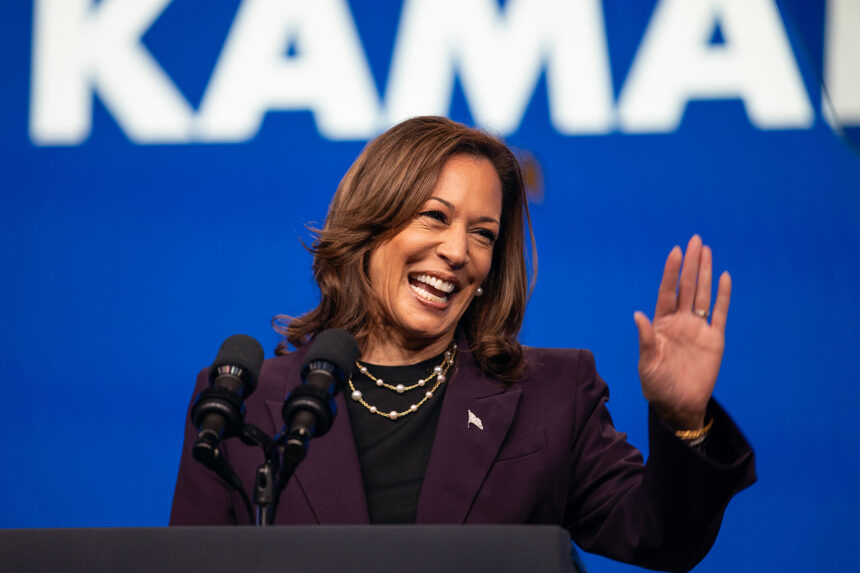The article explores the rise of Kamala Harris as the Democratic nominee for the 2024 U.S. presidential election following Joe Biden’s withdrawal. It emphasizes a significant change in American politics, with younger generations, such as Gen Z and Millennials, becoming more influential in shaping political outcomes.
Harris’s campaign has seen remarkable success, with strong fundraising efforts and a significant increase in voter registration. The article highlights that this election could be a crucial moment for Democrats, fueled by the energy of younger voters and the evolving landscape of American politics.
Read more below.
Is America Ready for Kamala Harris?
President Joe Biden’s late withdrawal from the election has given Democratic nominee Kamala Harris limited time to impact the election. There are some crucial numbers in key areas, however, that give her a fighting chance.
Within a week of announcing her candidacy, Kamala Harris set a record for the most money raised by a presidential candidate in 24 hours. This surge in fundraising was accompanied by a remarkable 700 percent increase in daily new voter registrations on Vote.org within 48 hours of her announcement. While this sudden burst of activity might surprise some, it represents a critical juncture in American politics. The increase in voter registration and fundraising reflects a crucial stage where the growing energy and engagement of younger generations could shift the dynamics of the election, marking a significant shift in the electoral landscape that political scientists and the country at large have been anticipating.
Since Donald Trump’s election in 2016, America has seen a conservative wave of policies, largely through the influence of down-ballot elections and the appointment of three conservative supreme court justices. A large portion of Trump’s voters during this period were baby boomers, and the proportional weight of this key demographic has been slowly but steadily decreasing since. 2024 will be the first year that Gen Z and Millennials combined are likely to account for as many votes as Baby Boomers and their elders, signalling the end of their majority in the electorate.
Democrats have been waiting for this shift for decades, aware that elections in swing states and solidly red (Republican) states would remain an uphill battle until a younger generation came to voting age. The training of grassroots organisers in Texas Democrat campaigns, for example, has often included predictions on when Texas is likely to become a swing state. Participants are advised that canvassing for Democrats in earlier elections may not be initially successful. The intent is to develop an expectation that this will change in future cycles.
Former Presidential Candidate Hillary Clinton echoed these sentiments in a New York Times piece last week, expressing her disappointment in not prevailing against Trump, but also her pride in normalising the presence of a woman at the top of the ballot, paving the way for candidates like Harris. It’s important to also remember that while Clinton won the popular vote by over three million, it was her loss of crucial swing states that mattered.
Nearly a decade later, America has learned some crucial lessons. Firstly, a Trump presidency, and all that that implies, is possible. Americans once dismissed the former reality TV star with a reputation as a womaniser as a serious presidential candidate. Feeling reassured by such logic, many people with limited access to voting stayed home, feeling safe in their decision. Even while Biden was president, the overturn of Roe vs Wade, the growing momentum of Project 2025, and support for state congressional bills like “Don’t Say Gay” have shown that a deepening effort by Americans from all walks of life will be needed to defeat the rising tide of alt-right conservatism.
Unlike the massive super PACs backing conservative candidates, many Democratic households lack the disposable income to pour into political campaigns. As a result, voters are taking desperate measures to make sure they make it to the polls: taking unpaid days off work, cutting back on daily expenses, and even setting aside money for rideshares just to cast their vote. Voting is a considered a privilege, and is not compulsory in the US, and many who are consistently disadvantaged by conservative policies are making sacrifices to ensure their livelihoods aren’t further damaged by another Trump administration.
Secondly, the influence of the Millennial and Gen Z voting population should not be underestimated. These younger voters are not only beginning to outnumber older, conservative demographics but are also demonstrating organisational skills that traditional political consulting firms struggle to match. In 2020, they famously reserved tickets to Trump events that went empty, as well as flooding social media with memes and orchestrating digital campaigns to drive democrat voter turnout and highlight crucial issues. Today, phrases like “brat summer” and “project coconut tree 2025” are gaining traction online, driven by popular artists like Charlie XCX and Chappell Roan. The GOP’s conventional strategies, including focus groups and late-night talk shows, are outpaced by the rapid spread and appeal of viral content created by younger generations.
Lastly, this is a crucial do-or-die moment, and one the Democrats have long anticipated. Although the phrase “this is the most important election of our lives” has often been used in US campaigns, the urgency is especially palpable now, particularly among younger voters. This is the election the DNC has been waiting for, with demographic shifts finally aligning to potentially achieve their progressive tipping point. The Harris campaign represents the culmination of this anticipation. Once rallying behind Biden, younger voters now see Harris—a younger woman of color—as the candidate who truly embodies their progressive aspirations and energy, marking a pivotal moment for the Democratic Party.
The 2024 election highlights a significant demographic shift: approximately 41 million members of Generation Z will be eligible to vote, with over eight million new potential voters having reached voting age since the 2022 midterms. Although younger voters have historically voted in smaller numbers, compared to older generations, their potential to impact the election is substantial if they turn out in force. Even Black Lives Matter activists, who once slammed Harris’s background as a “cop prosecutor,” are now calling on her experience to take out Trump in a “prosecutor vs. convict battle.” to demean Trump. This shift in attitude and age may be the final push needed for Democrats to be back in the presidential race.
For the time being, while Harris has gained unprecedented traction, Republicans have become stuck in a campaign loop attached to the targett “Sleepy Joe.” Trump and his followers will inevitably double down, but the position they held just over 100 days ago no longer exists.
In sum, America is showing clear signs that it has learned from at least some of the lessons of the past decade and may be ready to make a significant leftward shift. The recent surge of activity and engagement reflects a broader realisation that conservative policies have not been to their benefit. This momentum, driven by increased voter participation and energy from younger generations, highlights a crucial moment. The coming months will determine whether this renewed drive for progressive change will translate into a decisive electoral shift or remain an unfulfilled promise.
By: Emily Mosley – the National Operations Manager of the Australian Institute of International Affairs. She worked on presidential campaigns at a grassroots level for Beto O’Rourke, Pete Buttigieg, and Joe Biden and at a staff organiser level for Micheal Bloomberg. She has won the George H.W. Bush Daily Point of Light Award and The Congressional Award from US Congress for her efforts in GOTV and voter activism efforts.
Source: Australian Institute of International Affairs







